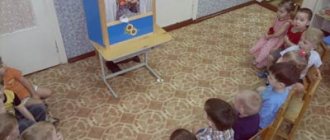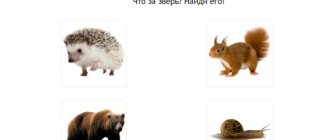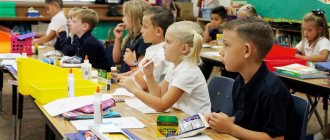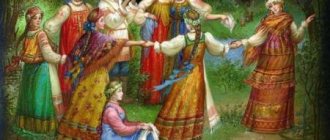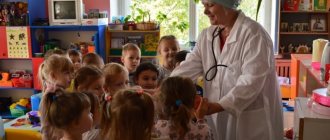Directions for using folklore creativity in a child’s speech development
Folklore is a means that influences various aspects of the personality and helps its full and comprehensive development.
Folklore creativity develops a child’s speech from birth. Speech development based on folklore is carried out in the following areas:
Are you an expert in this subject area? We invite you to become the author of the Directory Working Conditions
- Expanding and enriching the child’s vocabulary. The first songs, nursery rhymes, and nursery rhymes are constructed in such a way that they influence the child’s thinking and the part of his brain that is responsible for speech functioning. Hearing nursery rhymes and nursery rhymes, the child strives to repeat them, since the rhythm of these works and their style activate speech processes. Lullabies form the basis of smooth pronunciation and expand a child’s vocabulary.
- Formation of the articulatory apparatus. The organs of articulation take an active part in speech activity. Also, they are actively used in oral folk art: singing songs, ditties, observing their rhythm, forcing them to perform certain movements with the organs of articulation. This trains them, forms their muscle muscles and develops coherence and rhythm of the articulation organs.
- Formation of phonemic hearing. It is carried out on the basis of listening to various forms of folklore. Folklore and its forms have their own specific characteristics, properties that have a positive effect on auditory perception.
- Sample for writing descriptive stories. Folklore is a model for constructing certain texts: fairy tales, sayings, tongue twisters, etc. This builds and expands verbal communication skills.
Finished works on a similar topic
Course work The role of folklore in the development of verbal communication of children 440 ₽ Abstract The role of folklore in the development of verbal communication of children 280 ₽ Examination The role of folklore in the development of verbal communication of children 190 ₽
Receive completed work or specialist advice on your educational project Find out the cost
Children's folklore
Children's folklore is a bright world that is filled with the beauty and power of life. He coexists with the world of adults, but cannot submit to it. They exist according to their own laws and in accordance with their vision of the relationship between people and nature.
Children study with great curiosity the lives of the adults around them. They easily adopt experience, but change it and adapt it to their capabilities. Children's thoughts are associated with certain images. This is the key to the secrets of a child’s creative abilities.
The child's psyche has characteristics that must be taken into account when choosing works to work with.
Works of folklore teach students to distinguish evil from good, teach them to fight the bad, protect the weak, and be caring and generous towards nature.
Thanks to songs and nursery rhymes, children acquire stronger impressions of the positive impact of work on a person. Small folklore works created specifically for children are a treasure trove of folk wisdom.
Children love to listen to lullabies, read fairy tales, and repeat nursery rhymes. This is one of the good tools for nurturing a child's personality. According to G.S. Vinogradov, the people had natural ideas and views on society, which are still of great value for fulfilling the tasks of training and education. These instruments have been passed down from generation to generation for centuries. Therefore, folklore can rightfully be called folk pedagogy.
Children's folklore is an independent section of folklore intended for young children. The specificity of this phenomenon is that it combines poetry, gaming techniques and songs, as well as dances and games. Children should definitely play! And this is where folklore comes to our aid.
Children's folklore works make it easy to establish emotional contacts and communicate. Children have a vivid imagination and are attracted to rich content and strong artistic images. This allows them to enjoy life and develop as individuals.
Simple and unpretentious, children's folklore works contain great riches.
Modern kids need similar relationships with the world around them as those who lived in distant years. They need bathing, rocking, playing, etc.
Over the centuries, with the help of folklore, adults taught children and developed a high moral culture in them.
Thanks to the fact that children get acquainted with folklore, this forms their attention and interest in the surrounding reality, in folk customs, and helps them acquire artistic taste. This can teach you a lot. Children's speech develops, moral habits are formed, and knowledge about the natural world is acquired.
Catchphrases usually have a form that is accessible to children; teasers are easy to remember and can be actively used in games. Children's folk art is a special area of folk art that unites the children's world with the world of adults and creates a system of genres.
Folklore contains works of creativity, knowledge and wisdom of the people, collected over many centuries. It expresses the interests, inclinations and tastes of the people. It plays a big role in the lives of children, awakens positive emotions in them, and develops interest. According to O.I. Kanitsa, children’s folklore has an interesting feature - although it is intended for children, its bearers are often adults.
With its help, you can have a very powerful educational impact on children, since they draw a lot of knowledge from folklore. Also, a child’s acquaintance with poetry begins with small folklore. Just a few simple folklore lines contain huge reserves of genre wealth.
The use of proverbs and sayings in a child’s speech development
Proverbs and sayings are a type of poetic creativity that contains the wisdom of the people accumulated over centuries.
Proverbs and sayings are actively used as a means of speech development for preschool children. In addition, they find application in speech therapy practice, i.e. used in speech development correction programs.
The use of proverbs and sayings as a means of developing the speech of a preschooler contributes to the achievement of the following tasks of speech development:
- Formation of laconic speech;
- Clarity of pronunciation;
- Clarity and brightness of speech, expression of thoughts and feelings;
- Giving speech a scientific flavor;
- Formation of the foundations of creative orientation in the use of various speech structures;
- Formation of the foundations of imaginative thinking and imaginative description of various objects, processes and phenomena of the surrounding world;
- Giving the text describing something brightness and emotional richness.
The use of proverbs and sayings should be implemented on the basis of the principle of transition from simple to complex, i.e. you need to start by studying simple proverbs and sayings, gradually complicating them. This will make it easier for children to understand their meaning and meaning, as well as their place in the speech process.
At the final stage of working with proverbs and sayings, the creative direction of the activity is realized. It involves children composing proverbs and sayings on a specific topic, with a specific meaning.
When studying proverbs and sayings, it is good to use drawing them and writing stories based on them. This makes learning more fun and goal-oriented. The child strives to understand the meaning of proverbs and sayings and their correct use in his own speech.
Age-related features of speech development
Mastering speech is the most important task for a child at an early stage of development. All his progress in the future will depend on this skill, with regard to personality, intelligence and behavior.
What changes in speech from one to three years:
- the child learns basic grammatical and phonetic laws. A syntactic speech structure is formed.
- Semantic and lexical speech laws are being improved.
- the baby begins some speech activity, which is expressed in the form of questions that are addressed to adults.
Terminology
Lexis is a term that implies a system of words in a language that a person speaks. Semantics is a set of rules that consider the meanings of words and their changes in their meanings. Phonetics is a branch of linguistics that studies speech sounds and the structure of language. Grammar is the laws of word formation and the use of words in life.
At about a year old, the child can already pronounce some words. He names some things with words. For them, a word is usually associated with the current environment, rather than with specific ideas. At this age, preschoolers already have some experience of interacting with the outside world using their sensory organs. He already has certain feelings for his parents, for his environment, for toys and food.
From about one and a half to two and a half years, the next stage of child development occurs. During this period, the baby learns to combine words and combine them into small phrases. Children begin to be active in communicating with people, ask what the objects in their environment are called, and with the help of facial expressions and gestures indicate to the adult what is interesting to them. By about 1.8 years, children develop an understanding of the speech of others, but their active vocabulary is practically not replenished with new words.
Children aged one and a half years know up to 40 words. Very rarely do they understand up to 100 words. Then there is a strong leap in speech formation. At the end of the second year of life, preschoolers already know about 300 words. And by the end of three years - up to 1500 words. Phonemic hearing is almost completely formed at two years of age, when children can distinguish words that differ from each other by just one phoneme.
Closer to three years, the child begins to actively participate in independent speech. At this stage, children use their speech to control their own behavior and try to influence the behavior of people around them. Children's interest in the world around them is growing sharply. Children want to see, touch, listen and learn everything. They are interested in the names of objects, understand what these objects are for, and know how to use hygiene products.
At three years old, children use cases correctly and can compose sentences using function words, within which all words agree grammatically correctly. Passive vocabulary is almost the same as active. From two to three years, grammatical structure develops intensively. Some words turn into parts of speech, their endings are consistent. Speech at the age of three includes mostly simple sentences.
At an early age, speech can develop under the influence of the following factors:
- games influence the formation of speech;
- folklore must be used;
- development of fine motor skills;
- family communication.
The work of a teacher, which allows the formation of children's speech, implies that adults must be involved in interactions with children in everyday life. But you also need to specially organize activities and games.
Related posts:
- What is "War and Peace" about? Summary of the novel “War and Peace” by chapters. All answers...
- Play in sensory education The role of play in sensory development - which didactic games are suitable...
- Logorhythmic classes and correctional means By various means, speech therapy classes contribute to the effective correction of speech in children...
- From experience in diagnosing and forming creative imagination Research on creative imagination - diagnosis and its formation in children...
The use of riddles in the speech development of children
Riddles have a positive impact on the development of a preschooler’s thinking and shape his speech in the following aspects:
- Expanding a preschooler's vocabulary due to the ambiguity of concepts used in riddles. Children learn words and their different meanings, as well as the use of literal and figurative meanings of words in their verbal communication;
- Mastering the grammatical structure of speech. The riddle forms the child’s idea of how to construct sentences correctly, observing all the rules. The linguistic form of riddles motivates to analyze the structure of words and sentences;
- Mastering the sound side of speech. There is a development of auditory perception of speech, its meaning, presentation in various forms, using expressive language means;
- Formation of correct diction of a child. When pronouncing riddles, speech becomes concise and grammatically correct. This develops the skills of clear pronunciation and concise expression of one’s thoughts.
Recommendations for using folklore as a means of child speech development
In order for folklore to have the desired effect in a child’s speech development, one should rely on a number of recommendations for its use:
- Acquaintance with folklore from birth. Lullabies, nursery rhymes, and rhymes help in the formation of smooth and clear speech from the very beginning of its formation.
- Using gaming techniques when getting to know folklore. The game best helps in mastering the world around us and its various aspects.
- Explanation of unfamiliar words used in folklore.
- Explanation of fairy tales and other forms of folklore in your own words. This simplifies children’s understanding of the essence of the work and guides them towards developing grammatically correct speech.
- Emotional presentation of folklore.
- Motivation for getting acquainted with oral folk art.
Get paid for your student work
Coursework, abstracts or other works
